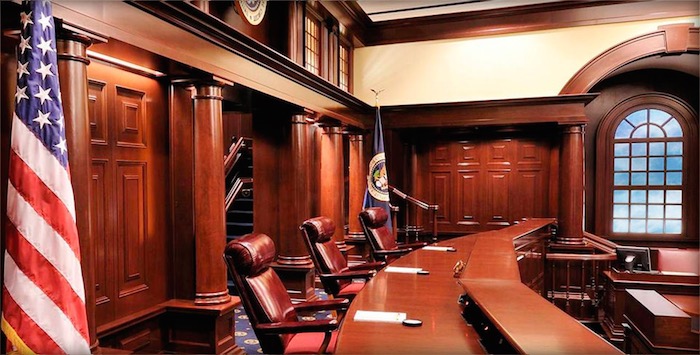“Independent and dependent claims ‘must if possible be interpreted to be consistent with each other.’” – CAFC
 On Tuesday, the U.S. Court of Appeals for the Federal Circuit (CAFC) vacated and remanded a decision of the U.S. District Court for the District of Nevada denying Power Probe’s request for a preliminary injunction to bar future sales of Innova Electronics Corporation’s Powercheck #5420 device. The CAFC held that the district court erred in its preliminary claim construction, particularly in determining that “detecting continuity and measuring continuity are mutually exclusive.”
On Tuesday, the U.S. Court of Appeals for the Federal Circuit (CAFC) vacated and remanded a decision of the U.S. District Court for the District of Nevada denying Power Probe’s request for a preliminary injunction to bar future sales of Innova Electronics Corporation’s Powercheck #5420 device. The CAFC held that the district court erred in its preliminary claim construction, particularly in determining that “detecting continuity and measuring continuity are mutually exclusive.”
The claims at issue are 1, 2, 5 –10, 12 and 13 of U.S. Patent 7,184,899, which is directed to an “electrical test device having multi-meter functionality that measures a plurality of parameters.” In its preliminary claim construction, the district court held that “a plurality of parameters” means “at least two parameters,” and noted that the Powercheck #5420 device measures only one parameter (voltage). It also found that Innova’s product “detects, but does not measure, continuity,” and that Power Probe had therefore not established a likelihood of success in proving infringement. Power Probe appealed, arguing that the court erred in finding that “continuity” is a parameter not capable of measurement and that the ’899 patent’s specification and the plain language of claims 10 and 12 teach that continuity is capable of measurement.
The CAFC first rejected Innova’s argument that Power Probe had forfeited its claim construction argument as it was inconsistent with its original argument that there need not be any claim construction, since “continuity measurement” should be afforded its plain and ordinary meaning. “While Power Probe’s statements in its claim construction brief and on appeal are
not verbatim identical, neither are they fundamentally inconsistent,” said the court.
Turning to the merits, the CAFC said the patent’s specification clearly shows the inventor used the term “continuity” as a measurable quantity, since it defines “parameters measurable by the electrical test device” as including “circuit continuity.” Claims 10 and 12 also directly refer to measurement, and “although claim 3 recites ‘detecting continuity,’…the district court wrongly assumed that detecting continuity and measuring continuity are mutually exclusive.”
The CAFC compared the case to Trustees of Columbia Univ. in City of New York v. Symantec Corp., in which the court held that “because the dependent claims [in] patents are presumed to be narrower than the independent claims on which they depend, ‘anomalous’ cannot be read to limit the type of data used to model [] only attack-free data in the independent claims in the absence of other evidence rebutting the presumption.” Likewise, in the present case, the district court “improperly construed independent claim 1 to exclude ‘continuity’ limitations included in dependent claims 10 and 12 that describe ‘continuity’ as measurable.” The court further advised that independent and dependent claims “must if possible be interpreted to be consistent with each other” and ultimately vacated and remanded the case for further proceedings on the preliminary injunction request.
The CAFC also recently issued a precedential decision in Littelfuse, Inc. v. Mersen USA EP Corp. clarifying how U.S. district courts handling claim construction are to construe a patent’s independent claims in light of limitations included in dependent claims.

![[IPWatchdog Logo]](https://ipwatchdog.com/wp-content/themes/IPWatchdog%20-%202023/assets/images/temp/logo-small@2x.png)

![[Advertisement]](https://ipwatchdog.com/wp-content/uploads/2024/04/Artificial-Intelligence-2024-REPLAY-sidebar-700x500-corrected.jpg)
![[Advertisement]](https://ipwatchdog.com/wp-content/uploads/2024/04/UnitedLex-May-2-2024-sidebar-700x500-1.jpg)
![[Advertisement]](https://ipwatchdog.com/wp-content/uploads/2024/04/Patent-Litigation-Masters-2024-sidebar-700x500-1.jpg)

![[Advertisement]](https://ipwatchdog.com/wp-content/uploads/2021/12/WEBINAR-336-x-280-px.png)
![[Advertisement]](https://ipwatchdog.com/wp-content/uploads/2021/12/2021-Patent-Practice-on-Demand-recorded-Feb-2021-336-x-280.jpg)
![[Advertisement]](https://ipwatchdog.com/wp-content/uploads/2021/12/Ad-4-The-Invent-Patent-System™.png)






Join the Discussion
One comment so far.
Yenrab 315
April 15, 2022 09:03 amThe question resolved by the Fed Cir seems to be whether measuring a binary value (whether some level is over or under a threshold) is really measuring or just “detecting”. In most cases an electrical engineer would see detecting a binary ON or OFF as measuring, especially if the patent specification says it is. I don’t think I can read any more than that into this decision.